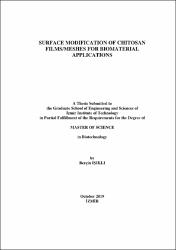Please use this identifier to cite or link to this item:
https://hdl.handle.net/11147/9646| Title: | Surface modification of chitosan films/meshes for biomaterial applications | Other Titles: | Biyomalzeme uygulamaları için kitosan film ve ağların yüzey modifikasyonu | Authors: | Işıklı, Berçin | Advisors: | Tıhmınlıoğlu, Funda | Keywords: | Surface modification Ion implantation Polymeric film Chitosan Biodegradation Biomaterials |
Publisher: | Izmir Institute of Technology | Source: | Işıklı, B. (2019). Surface modification of chitosan films/meshes for biomaterial applications. Unpublished master's thesis, İzmir Institute of Technology, İzmir, Turkey | Abstract: | Modification of surface of biomaterials is a great interest for many years due to first contact of surface of materials with the biological fluids. This thesis aims to investigate surface modification effect on the chemical, surface wettability, protein adsorption as well biodegradability properties of dense chitosan (Ch) and asymmetric chitosan films (ACh). The surfaces of chitosan dense and asymmetric films were modified by ion implantation technique using carbon and carbon-nitrogen hybrid ions at a fluence of 1x1015 ions/cm2 and ion energy of 20kV. Chemical compositions of the film surfaces were analyzed by Fourier transform infrared spectroscopy (FTIR-ATR). Surface hydrophobicity measurements were conducted by static contact angle measurements. Protein adsorption on unmodified and modified surfaces on films was investigated as a function of time at various pH conditions. After ion implantation on chitosan films, both C and C-Nitrogen ion implantation, the surfaces become rougher and hydrophobic having moderate wettability (����� values in the range of 72-85°) and in good agreement with FTIR-ATR data findings. It was found pH dependence of the amount of protein adsorbed on the dense chitosan films as a function of time for both un-implanted and implanted films. BSA and fibrinogen were more adsorbed on the chitosan films at pH 5. The amount of BSA and fibrinogen protein adsorption was 0.97 and 1.33 gprotein/gfilm, respectively for 60 min incubation period. Protein adsorption enhanced for C and C+N2 ion implanted samples for BSA and fibrinogen, respectively due to the hydrophobic protein surface interaction effect. In vitro degradation results showed that ACh films degrade much faster (mass loss 57 %) than Ch films (40 %) due to the porous structure at the end of 3 weeks. However, the ion implanted Ch samples degraded much slower having mass loss of 30% and 17.7% for C+N2 and C implanted samples, respectively at the end of 3 weeks compared to un-implanted Ch films as 40 %. The results are in good agreement with water sorption and surface hydrophobicity of the implanted films. This study demonstrated that surface modification, as well as structure, changes the protein sorption, wettability and biodegradation properties of the chitosan films. Biyomalzemelerin yüzeylerinin değiştirilmesi, biyolojik ortam ile ilk teması malzeme yüzeyinin yapması nedeniyle büyük ilgi görmektedir. Bu tez, yoğun ve asimetrik kitosan filmlerin kimyasal, yüzey ıslanabilirliği, protein adsorpsiyonu ve biyolojik olarak parçalanabilirlik özellikleri üzerindeki yüzey modifikasyon etkisini araştırmayı amaçlamaktadır. Kitosan (Ch) yoğun ve asimetrik (ACh) filmlerin yüzeyleri, 20kV iyon enerjisi ve 1x1015ions/cm2 yonlukta karbon ve karbon-azot hibrit iyonları ile iyon implantasyon tekniği ile geliştirildi. Film yüzeylerinin kimyasal bileşimleri, Fourier dönüşümü kızılötesi spektroskopisi (FTIR-ATR) ile analiz edildi. Statik kontak açısı ölçümleri ile yüzey hidrofobikliği ölçümleri yapıldı. Modifiye edilmiş ve edilmemiş filmlerde protein adsorpsiyonu çeşitli pH koşullarında zamanın bir fonksiyonu olarak incelenmiştir. Kitosan filmlere, hem C hem de C-Azot iyon iyon implantasyonundan sonra, yüzeyler daha pürüzlü ve hidrofobik hale gelmiş olup, kontak açıları orta ıslanabilirliğe (72������85°) çıkmıştır. Bu veriler ile FTIR-ATR bulguları uyum içindedir. Yoğun kitosan filmlerine adsorbe edilen protein miktarının, hem implante edilmemiş hem de implante edilmiş filmler için zamanın bir fonksiyonu olarak pH etkisi çalışılmış, pH 5'te tutunmanın daha fazla olduğu görülmüştür. BSA ve Fibrinogen protein adsorpsiyon miktarı, 60 dakika inkübasyon sonrası 0,97 ve 1,33 gprotein/gfilm olarak bulunmuştur. Protein, hidrofobik yüzey etkile��iminden dolayı BSA ve Fibrinogen için C ve C+N2 iyonuyla implante edilmiş örnekler için protein adsorpsiyonu artmıştır. ��n vitro bozunma sonuçlarına göre, ACh filmler 3 hafta sonunda gözenekli yapıları nedeniyle yoğun kitosan filmlerden (%40) daha hızlı kütle kaybı gösterdi. Bununla birlikte, implante edilen C+N2 ve C ile implante edilen Ch filmler 3 hafta da %30 ve %17,7'lik kütle kaybı yaşamıştır. Implante edilmemiş Ch film numuneleri ise, çok daha yavaş bir şekilde, 3 hafta sonunda %40 bozulma görülmüştür. Bu sonuçlar, implante edilmiş filmlerin su emilimi ve yüzey hidrofobikliği sonuçları ile iyi bir uyum içindedir. Bu çalışma yüzey modifikasyonunun, yapının yanı sıra, kitosan filmlerinin protein emilimini, ıslanabilirliğini ve biyolojik bozunma özelliklerini etkilediğini göstermiştir. |
Description: | Thesis (Master)--Izmir Institute of Technology, Biotechnology and Bioengineering, Izmir, 2019 Includes bibliographical references (leaves: 70-87) Text in English; Abstract: Turkish and English |
URI: | https://hdl.handle.net/11147/9646 |
| Appears in Collections: | Master Degree / Yüksek Lisans Tezleri |
Files in This Item:
| File | Description | Size | Format | |
|---|---|---|---|---|
| 10308714.pdf | MasterThesis | 5.55 MB | Adobe PDF |  View/Open |
CORE Recommender
Page view(s)
208
checked on Jul 22, 2024
Download(s)
282
checked on Jul 22, 2024
Google ScholarTM
Check
Items in GCRIS Repository are protected by copyright, with all rights reserved, unless otherwise indicated.